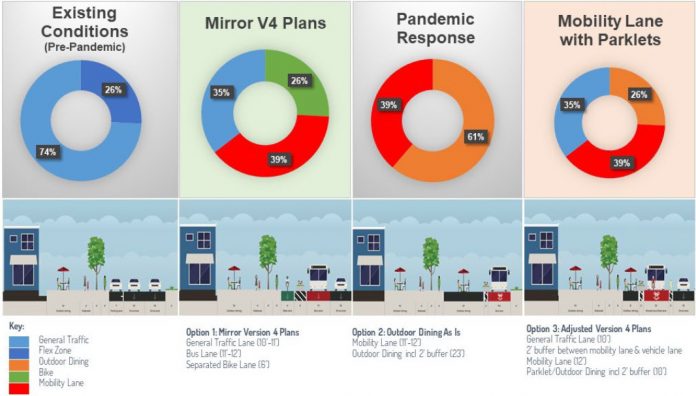The city council moved to maintain the parklet for businesses in Downtown Culver City while waving land use fees for those businesses through Labor Day. City staff was given direction to prepare for a potential transition to mirror the plans of the Move Culver City pilot, but the discussion was inconclusive and will be continued at a later date.
The need to implement this stems from the fact that while reopening, businesses need time to recover, and the parklet system was a well received way to help restaurants in Downtown Culver City work their way back.
The supportive programs including outdoor parklet systems were a huge success, with businesses expressing gratitude for programs and desire to extend them at a Economic Recovery Task Force (ERTF) meeting on the subject.
Following feedback from the general public, the project, which would be implemented westbound on Culver Boulevard in Downtown Culver City, followed three main considerations in its conception: keeping a separated bike lane, maintaining outdoor dining, and maximizing auto access.
Prior to the pandemic, all lanes were used for mixed traffic and parking. 74% of lane space was reserved for multiple lanes of general traffic.
During pandemic, the city implemented a completely new street structure that included a 12 foot bus/bike mobility lane and 21 feet of outdoor dining space with a two-foot buffer
One of the alternative options presented at Monday’s meeting was a plan that mirrored the final plans, known as Version 4, of the Move Culver City Tactical Mobility Lane pilot currently being implemented. This would include one general traffic lane, a bus lane and separated bike lane. However, this would not maintain on street parklet
Additionally, there was a second alternative plan with a mobility lane and the parklet. This would include a general 10-foot traffic lane, a 12 foot mobility lane with a two-foot buffer from traffic, and a 10-foot parklet/outdoor dining with two-foot buffer
While the Version 4 plans were suggested by Move Culver City and staff, many constituents spoke out in favor of the alternative that maintained the outdoor parklet. Among the supporters for this proposal is Culver City Chamber president Collin Diaz, who spoke in support of the inclusion of both an outdoor parklet and traffic lane in the plan. Another notable name to support the traffic lane/parklet option was Darrel Menthe, who is president of the Culver City Downtown Business Association and was the first person to propose outdoor parklets for restaurants.
Following approval, staff estimates that there would be a 14-16 week implementation time. There was a discussion as to when to implement the project and begin construction, as it would impede business operations. A suggestion to delay the construction by three months was suggested, but would incur an additional cost.
The extra cost of $150,000 to “remobilize” according to Cruz was unclear to councilmember Goran Eriksson, Cruz explains that teams and consultants would be needed to maintain and assess things after the fact.
Councilmember Albert Vera was the first to speak, asking about the viability of keeping the lane the way it is during the pandemic. However, staff explained that a traffic lane is considered necessary in the long term to prevent traffic issues.
Following a majority of the comments and the preference of Menthe, Vera supported the traffic lane/parklet option, and called it a great compromise between the Move Culver City initiative and the residents and business owners of the city. He also supported the three month delay.
Councilmember McMorrin feared a “return to the status quo,” and expressed her support for the Version 4 plan. She also said that she hopes to collect more data, and believed equity had a part to play in the discussion.
She also noted the environmental impact, and moving towards not being reliant on cars.
Eriksson compared this to a similar project years ago on Washington Boulevard that was eventually turned into a plaza, believing that the net effect is a decrease in car space. He emphasized the fact that having the traffic lane is necessary for hotels, drop off at local restaurants, and other uses.
He also noted that cars are going to be the preferred mode of transportation for “a long time,” and that needs to be taken into consideration. For the long term, Eriksson brought up the question of whether or not restaurants want to pay for the fee to use the public space for the parklet for a long period.
Vice Mayor Daniel Lee said that in the long term, the council has a great deal of influence in setting what people expect to see in Culver City, and that moves should be made to create the future that we want to see as opposed to dictating them in the present.
He also noted the connection with housing and the potential increase in density, and said that past councils have focused too much on facilitating the traffic that doesn’t start or end in Culver City. Lee was in favor of the Version 4 option, but also believed more data was needed.
“We don’t really know how what we have done during the pandemic translates into the real world,” Lee said.
After briefs discussion to clarify points regarding the specifics of the motion, the motion to maintain the current lane and fee waiver until Labor Day while preparing to implement the Version 4 plans. This motion passed 3-2 with Vera and Eriksson dissenting.













